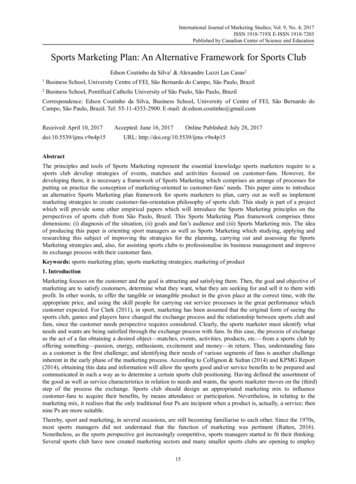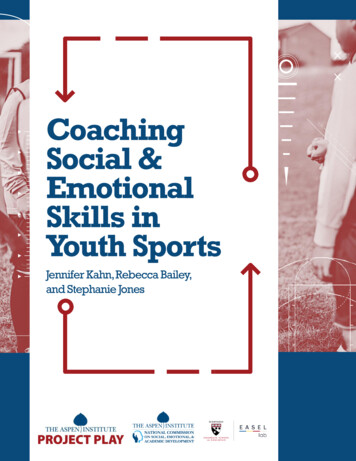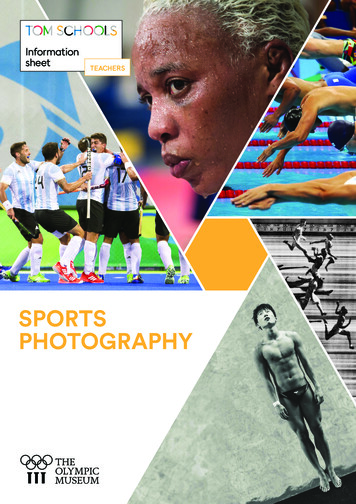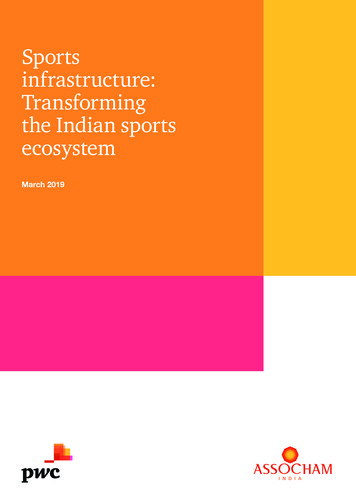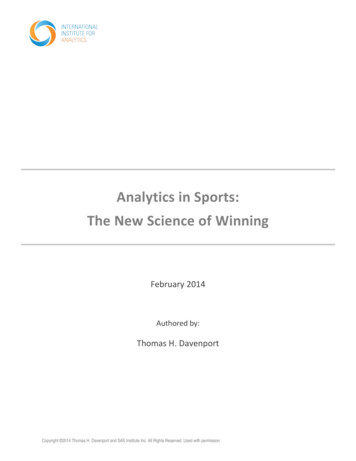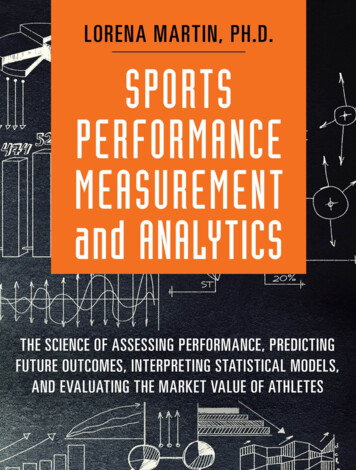
Transcription
Global Journal of Arts, Humanities and Social SciencesVol.8, No. 2, pp.62-74, February 2020Published by ECRTD-UKPrint ISSN: 2052-6350(Print), Online ISSN: 2052-6369(Online)EFFECTS OF SPORTS PARTICIPATION ON THE ACADEMIC PERFORMANCEOF SENIOR HIGH SCHOOL STUDENTS IN MATHEMATICSChristopher YarkwahDepartment of Mathematics and ICT EducationUniversity of Cape Coast, Cape Coast, Ghanacyarkwah@ucc.edu.ghEmmanuel AgyeiDepartment of Mathematics and ICT EducationUniversity of Cape Coast,Cape Coast, Ghanaemmanuel.agyei@stu.ucc.edu.ghABSTRACT: The primary purpose of this study was to investigate the effect of engaging insporting activities on the academic performance of students in mathematics at the senior highschool level in the Cape Coast Metropolis. To ascertain the main objective of the study,descriptive survey design was employed. The study used 100 senior high school studentscomprising 59 student-athletes and 41 non-student athletes. For data collection, eachrespondent was presented with the research questionnaire designed for the study. The studyrevealed that, there is no statistically significant difference between the performance of studentathletes and non-student athletes in mathematics. The study, however, concluded that, sportsparticipation has no negative effects on students-athletes’ academic performance inmathematics. What this finding implies is that, parents and mathematics teachers should notseize students from participating in sporting activities with the fear that participating in sportsworsens academic performance.KEYWORDS: effects, sports participation, academic performance, learning timeINTRODUCTION AND STATEMENT OF THE PROBLEMSports and its associated competitions across the globe have made participation in sportsappealing to several others in various parts of the world. It is asserted that, inside a healthy bodyis a sound mind. Choi, Johnson and Kim (2014) emphasized that sporting activities is a keyfactor in promoting healthy lifestyles among students who engage in sporting activities.Through sports, students learn social and cognitive skills. A student who partakes in sportingactivities is believed to have a sound mind and thus, the likelihood for him or her to excel in hisor her academics is very high. Generally, Bailey, Hillman, Arent, and Petitpas (2013) also62
Global Journal of Arts, Humanities and Social SciencesVol.8, No. 2, pp.62-74, February 2020Published by ECRTD-UKPrint ISSN: 2052-6350(Print), Online ISSN: 2052-6369(Online)identified that students’ participation in sports is associated with a cluster of benefits including:social, mental and cognitive wellbeing, and academic performance.However, there is a growing body of people who hold on to an assertion that students whoengage in sports activities do not perform well academically hence yielding a debate amongresearchers on the effects of students’ engagement in sports and academic performance. Thisdebate has been an issue of contention between several researchers over the previous decades.Some studies (See for example; Tomporowski, Davis, Miller, & Naglieri, 2008; Trudeau, &Shephard, 2008; DeMeulenaere, 2010) identified that engagement in sports have positiveinfluence on students’ academic performance. Tremblay, Inman and Williams (2000) revealedthat partaking in sports have negative effects on students’ academic performance. To identifythe effect of sports participation in Canada, Tremblay et al. (2000) discovered that a negativerelationship existed between sports participation and standardized test scores among students.It was espoused by Davis and Cooper (2011) that people who partake in sporting activities inschools argue that there exist no positive effects of sports on academic performance.Thorlindson and Bernburg (2006) observed that some parents associate sports with some illmannered behaviours. People who question the place of sports in educational institutions, claimthat sports participation results in poor performance by sportsmen and sportswomen. Thesecritics claim that students who participate in sports relinquish all their energies into training andpartaking in sporting activities and have less time and energy to dedicate to their academic work.Hartman (2008) asserted that “too much periods and energy emphasized on sports shifted focusfrom academic work of schools”. Hartman investigated quite a number of researches done toascertain the kind of relationship that exists between athletic participation and students’academic achievements. He found out that, most works done in this field claimed students losetheir motivation to pursue academic excellence when they get deeply engrossed in sportingactivities. On the contrary, Nelson and Gordon-Larsen (2006) discovered that students whoengage in sports perform well in science subjects. In a similar vein, Broh (2002) also identifiedgood results in English and mathematics for students who engage in sports.Since school sports teams require a huge amount of time for practices, games, fundraising andpre-season training on the part of the student athlete, it could be contended that if students areengaged in challenging subjects, they may not have time to maintain excellent grades.Nonetheless, Denault, Poulin and Pederson (2009), undertook a five-year longitudinal study ofstudents from grades 7 to 11, using interviews via telephones, questionnaires, and an analysisof academic records, and discovered that student athletes generally had enhanced potential toimprove their academic knowledge and expertise, and also to develop their interpersonalrelationships. In addition, Fredericks (2012) conducted a two-year study focused on theparticipation of 10th graders in school-based activities, in which surveys and transcripts showed63
Global Journal of Arts, Humanities and Social SciencesVol.8, No. 2, pp.62-74, February 2020Published by ECRTD-UKPrint ISSN: 2052-6350(Print), Online ISSN: 2052-6369(Online)that the amount of time spent in sporting activities was favourably related to academicperformance. Likewise, 400 athletes were studied by Jonker, Elferink‐Gemser, and Visscher(2009). These athletes who were enrolled in either pre-professional or pre-university schoolswere aged between 14 and 16. The results reported that, a high correlation existed betweenstudents’ involvement in athletics and academic performance in reading.In Ghana, sports form an integral part of the various activities carried out in all schools at alllevels in the academic year. This is evident as a result of the various sporting competitionsorganized for schools at all levels of education across the country. For instance, the inclusionof interschools athletics competitions and soccer competitions on schools’ academic calendarshows that the Ghana Education Service also believes sports to be beneficial to the students. Inevery year, athletics and football competitions are organized for students in basic schools, highschools and tertiary institutions in collaboration with the National Sports Council under theMinistry of Youth and Sports. In high schools, interschool’s athletics competitions are one ofthe hallmarks of high school life. It is a time on the school calendar where both teachers andstudents become actively involved in sports and there is general euphoria among students bothon school campus and outside their campuses.Learning can be observed differently and is often measured and evaluated through cognitiveand academic tests. A vast array of student achievements has been associated with participationin a physical activity. The current curriculum approved by Ghana Education Service for use inthe Senior High School makes four subjects compulsory for all high school students regardlessof the programmes one is offering. Mathematics is one of the core subjects in Ghana, for astudent to advance to the next phase of his or her education, it is required of him or her to dosignificantly well in core mathematics (which is a compulsory subject for all students at thehigh school level). The issue of students’ performance in mathematics is very paramount tomathematics educators. Irrespective of the various research studies that have been conductedacross the globe to ascertain the impact of sports participation on students’ academicperformance, a few of such studies have been conducted in Ghana and also none of the studiesconducted in the country has looked at the effect of sports participation on students’ academicperformance in mathematics at the Senior High School level. It is against this backdrop that thisstudy sought to examine the effects of sport participation on the academic performance ofstudents in mathematics.Research Questions and HypothesisThe following research questions were used to guide the study:1. To what extent do sports participation affect students’ performance in mathematics?2. To what extent does participation in sports affect students’ learning time?64
Global Journal of Arts, Humanities and Social SciencesVol.8, No. 2, pp.62-74, February 2020Published by ECRTD-UKPrint ISSN: 2052-6350(Print), Online ISSN: 2052-6369(Online)To ascertain the effect of sports participation on students’ academic performance inmathematics the research hypothesis below was also formulated:1. H0: There is no statistically significant difference between the performance of studentswho participate in sports and their counterparts who do not.Design and InstrumentationThis research focused on the effects of sports participation on academic performance of studentsin mathematics in the Cape Coast Metropolis. The study employed the descriptive survey designto collect data from senior high school students in the Cape Coast Metropolis using aquestionnaire. Cape Coast Metropolis was selected for the study because it is considered as thecitadel of education in Ghana. Most of the country’s best second cycle institutions are situatedin the Metropolis. This design was resorted to because according to Cresswell (2012) it is onedesign in which the investigator administers a survey to a sample or to the entire population ofpeople to describe the attitudes, opinions, behaviours, or characteristics of the subjects involved.Descriptive survey design enjoys the strength of explaining educational phenomena in terms ofthe conditions or relationships that exist, opinions that are held by students, teachers, parentsand experts (Cresswell, 2012). The data used for analysis in this study was acquired through theuse of a questionnaire. A four-point Likert scale questionnaire was used to illicit responses fromstudents concerning the effect of sports participation on their academic performance inmathematics. For this reason, close-ended and open-ended questions were designed to solicitthe desired answers from the participants. The open-ended questions gave students theopportunity to give out their own answers in written form concerning the phenomenon whereasthe close-ended questions gave them the opportunity to agree or disagree with perceptual itemsconcerning same subject.Selection of participantsThe focus of this study was to find out the effects of sports participation on the academicperformance of senior high school students in mathematics.Based on this reason, the study purposively selected 59 students who engage in sportingactivities and 41 of their colleagues who do not participate in sporting activities at the seniorhigh school level making 100 respondents. The respondents were drawn from five senior highschools in the Cape Coast Metropolis using the simple random sampling technique.Validity and Reliability of InstrumentThe phenomenon of interests in this study was to investigate the effects of sports participationon the academic performance of senior high school students in mathematics. The face validityof the instrument was determined by the researchers and colleagues in the area of mathematicseducation who are also experts in developing questionnaires, at the Department of Mathematics65
Global Journal of Arts, Humanities and Social SciencesVol.8, No. 2, pp.62-74, February 2020Published by ECRTD-UKPrint ISSN: 2052-6350(Print), Online ISSN: 2052-6369(Online)and ICT Education, University of Cape Coast and a peer review team. Their suggestions wereadhered to before the final questionnaire development. Cronbach alpha reliability test conductedon the items yielded an alpha value of 0.713 which was good enough. This is because the overallCronbach’s alpha co-efficient obtained indicate a strong reliability coefficient as emphasizedby Jackson (2015) that Cronbach’s alpha of 0.7 or more denotes strong reliability for the scale.Data Collection ProcedureTo be fair to the respondents and ensure high response rate of the items on the instrumentadministered as well as confidentiality, names of students who participated in the study werenot recorded on the instrument. An initial visit was paid to the schools as well as the students,which were finally involved in the research. At these meetings, permission was sought fromheads of the schools as well as students who were going to be involved in the study. At themeeting, the purpose of the study, its duration, and potential benefits were explained to theheads and teachers as well as all other participants for their consent to participate in the studyand also allow the study to take place in their respective schools. Also, at these meetings,decisions about dates and times for the administration of the instrument were taken. In eachschool, questionnaires were administered to the participating students in their respectiveclassrooms during classes normal class hours. Each session lasted for about forty-five minutes.The instruments were administered to all the 100 senior high school students who participatedin the study across the five schools. The administered instruments were supervised by theresearchers. The completed instruments were then collected from the students and analyzedbased on the phenomenon.DATA ANALYSIS AND DISCUSSIONAs already mentioned, data for this study was obtained from senior high school first to finalyear students in the Cape Coast Metropolis using a four-point Likert scale questionnaire. Theresponses to the four-point Likert scale questionnaire as provided by the respondents were firstedited, coded and entered as required. Since data collected from the field was meant to answerresearch questions that guided the study and as well as testing the hypothesis made in the study,data analysis was done and organized according to the study’s research questions andhypothesis.Data was analyzed and discussed quantitatively using graphs, frequencies, descriptive andinferential statistics (mean, standard deviation and t-test) to answer the research question and totest the hypothesis put forward in this study.66
Global Journal of Arts, Humanities and Social SciencesVol.8, No. 2, pp.62-74, February 2020Published by ECRTD-UKPrint ISSN: 2052-6350(Print), Online ISSN: 2052-6369(Online)RESULTS AND DISCUSSIONAnalysis of the demographic data of the respondents revealed that, there were 59 (59.0%) malestudents of which 40 (40.0%) of them participate in sports and 19 (19.0%) do not participate insports. There were 41 (41.0%) female students of which 19 (19.0%) of them participate in sportsand 22 (22.0%) do not engage in sports. There were as many as 87 (87.0%) students from theform two class while 5 (5.0%) and 8 (8.0%) students were from the forms one and three classesrespectively. Frequency counts and percentages were used to analyse the research questions.Research Question One:To what extent do sports participation affect students’ performance in mathematics?The first research question that guided this study was, “To what extent do sports participationaffect students’ performance in mathematics?”In answering the first research question, the results revealed that 54 (91.5%) student-athletesagreed that sports make them more active in class, 53 (89.3%) of them agreed that their gradesin mathematics had improved when they joined the sports team in the school, 47 (79.7%) of thestudents also agreed that sports have positive influence on their concentration in mathematicsand 45 (76.3%) agreed that sports do not affect their academic performance in mathematics.Furthermore, there are as many as 51 (86.5%) students who disagreed that sports make themretrogress in mathematics. In the same vein 52 (88.2%) of the student-athletes disagreed thattheir performance in mathematics has worsen when they joined sports. It can be inferred fromthe results that student-athletes had a positive perception towards mathematics even as theyparticipate in sporting activities. It also revealed that the performance of students in mathematicsis not worsened by their participation in sports. The finding is in line with the findings of Marshand Kleitman (2002) who found that scholastic accomplishment of students increased as theirparticipation level in sports also increased. In the same vein, National Association of StateBoards of Education (NASBE) (2004) found out that student-athletes beat non-athletes in termsof academic achievements with the gap broadening the more athletes participates in sports.Research Question Two:To what extent does participation in sports affect students’ learning time?The second research question that guided this study was, “To what extent does participation insports affect students’ learning time? To answer this research question, data from the studentparticipants were used for the analysis.Analysis of results revealed that, as many as 30 (50.8%) and 22 (53.7%) of the student-athletesand non-athletes respectively usually go to bed as late as 10:01 PM – 12:00 AM on school dayswhile 26 (44.1%) and 17 (41.5%) of the student-athletes and non-athletes respectively usuallygo to bed between 8:01 PM – 10:00 PM during weekends. Further analysis was conducted to67
Global Journal of Arts, Humanities and Social SciencesVol.8, No. 2, pp.62-74, February 2020Published by ECRTD-UKPrint ISSN: 2052-6350(Print), Online ISSN: 2052-6369(Online)determine the extent to which sports participation affects students learning time. The result ispresented in Figure 1.13.6%Once28.8%TwiceThrice33.9%More than thrice23.7%Figure 1: Number of Times Student-Athletes Participated in School Sport CompetitionThe student-athletes were asked to specify the number of times they participated in school sportscompetitions. A cursory look at Figure 1 revealed that majority of the student athletes[51(86.4%)] participate twice or more times in school sports competitions. This means that mostof the student athletes are committed and deeply involved many times in sporting activities asand when the slated time for such is due.Further analysis was conducted to verify the number of events these athletes are involved in.Figure 2 indicates the number of sporting events these student athletes are involved in.16.9%22.0%One11.9%TwoThree49.2%More than threeFigure 2: Number of Sports Events Student-Athletes are involved in68
Global Journal of Arts, Humanities and Social SciencesVol.8, No. 2, pp.62-74, February 2020Published by ECRTD-UKPrint ISSN: 2052-6350(Print), Online ISSN: 2052-6369(Online)Figure 2 indicates that 46(77.96%) of the student athletes engage in two or more sporting eventsfor their schools. This goes to buttress the number of times they participate in sportscompetition.Furthermore, to ascertain to what extent student athletes’ participation in sportingactivities affect their learning time, they were asked to specify the number of hours they practiceduring school days within a week. Figure 3 shows the number of hours’ student-athletespracticed during school days within a week.7% 2%20%1 – 4 hours5 – 9 hours71%10 – 14 hours15 – 19 hoursFigure 3: Number of Hours Student-Athletes Practiced within a week during the SchooldaysThe student-athletes were asked to specify the number of hours they practice during school dayswithin a week. the number of hours they practice in the past week during the school week.Figure 3 shows that 42 (71.0%) of the students practiced for 1 – 4 hours, 12 (20.0%) of thempracticed for 5- 9 hours, 4 (7.0%) of them practiced for 10 – 14 hours and 1 (2.0%) of the studentpracticed for 15 – 19 hours in the past week during the school week.To have a morecomprehensive information regarding the extent to which sports participation affect theirlearning time, the study ascertained the number of hours the student-athletes practiced in schoolduring the weekend. Results are presented in Figure 4.69
Global Journal of Arts, Humanities and Social SciencesVol.8, No. 2, pp.62-74, February 2020Published by ECRTD-UKPrint ISSN: 2052-6350(Print), Online ISSN: 2052-6369(Online)17%2%1 – 4 hours5 – 9 hours81%10 – 14 hoursFigure 4: Number of Hours Student-Athletes Practiced in school during the WeekendResults from Figure 4 revealed that 48 (81.0%) of the students practiced for 1– 4 hours, 10(17.0%) of them practiced for 5- 9 hours, 1 (2.0%) of them practiced for 10 – 14 hours. It canbe inferred from the previous analysis that student-athletes spend substantial amount of timeparticipating in sports in Senior High Schools resulting from the number of hours they spend intraining and practicing and the number of sporting activities they partake in. This finding is inconformity with the study of Ahamed, MacDonald, Reed, Naylor, Liu-Ambrose and Mckay.(2007) when they stated that even without jeopardizing their academic performance or progress,children can spend a little less time in academic learning and more time being physically activethroughout the school day. From the discussion, it was observed that, whether students-athletespractice or not majority wake up at the same time as compared to those that wake up at differenttimes and due to that it can be said that student-athletes practice time do not have any negativeimpact on their learning times.Research HypothesisH0: There is no statistically significant difference between the academic performance ofstudents who participate in sports and their counterparts who do not in mathematics.The research hypothesis that guided this study was, “There is no statistically significantdifference between the performance of students who participate in sports and their counterpartswho do not”. To answer this research hypothesis, data on students’ academic performance inmathematics were gathered and analysis performed using the independent-samples t-test. Theresults are presented in Table 1.70
Global Journal of Arts, Humanities and Social SciencesVol.8, No. 2, pp.62-74, February 2020Published by ECRTD-UKPrint ISSN: 2052-6350(Print), Online ISSN: 2052-6369(Online)Table 1: Marks of Students in the Recent Previous Mathematics ExaminationMarks (%)AthletesNon-Athletesfrequency%frequency%90 - 100714.049.880 – 891423.7717.170 – 792135.61229.360 – 691220.3922.058.5922.0Less than 60A critical look at Table 4 shows that, 7 (14.0%) of student-athletes had marks between 90 –100% as against 4 (9.8%) of non-student athletes, 14 (23.7%) and 7 (17.1%) of student-athletesand non-athletes had marks between 80 – 89% respectively, and 21 (35.6%) of student athleteshad marks between 70 – 79% as compared to 12 (29.3%) of non-student athletes. Also, 12(20.3%) and 9 (22.0%) of student-athletes and non-student athletes respectively had marksbetween 60 – 69%. In addition, 5(8.5%) of student-athletes had marks less than 60 while 9(22.0%) non-student athletes had marks less than 60%.A further test was done using the independent-samples t-test to determine if there exists anydifference in the performance of student-athletes and non-student athletes. This is presented inTable 2.Table 2: Results of t-test and Descriptive Statistics on Academic Performance of Studentathletes and Non-Student AthletesGroupSample MeanStandardDegrees of 70Results from Table 2 shows that, the mean score of student-athletes in their recent coremathematics examination was 2.90 and that of non-student athletes was 3.29. The mean andstandard deviation were calculated using the range of the scores of the students in their recentcore mathematics examination for all student-athletes and non-student athletes respectively.71
Global Journal of Arts, Humanities and Social SciencesVol.8, No. 2, pp.62-74, February 2020Published by ECRTD-UKPrint ISSN: 2052-6350(Print), Online ISSN: 2052-6369(Online)Though there is a difference in the means of the student-athletes and non-student athletes infavour of the non-student athletes, the standard deviation indicates that the performance of thestudent-athletes was more clustered than their counterparts who do not take part in sportingactivities.The t-calculated value was -1.635 and its p-value was 0.105 at 5% significant level. Since thep-value is greater than 0.05 significant level, we fail to reject the null hypothesis (H0). It istherefore concluded that, there is no statistically significant difference between the performanceof student-athletes and non-student athletes in core mathematics. This shows that theperformance of the two groups were almost the same. Hence, there is no difference in theperformance of the student-athletes and non-student athletes in core mathematics.This findingis not in conformity to the study of Marsh (1993) where he found a small, but significant,relationship between sports participation and higher academic achievement. Barber, Stone andEccles (2005) also found that student athletes earned higher grades and were more likely toattend college which proved otherwise by the finding in this study.CONCLUSIONS AND IMPLICATIONS FOR TEACHING AND LEARNINGMATHEMATICSThe conclusions drawn from the research findings indicate that sports participation have nonegative effect on the academic performance of student-athletes in mathematics. Also,participation in sports does not affect the learning time of students. Although students mayspend substantial amount of time in partaking in sporting activities, they still get time to learn.These findings have the implication that student-athletes should not be discouraged fromparticipating in sports with the misconception that participation in sports worsen students’general performance and specifically performance in mathematics. Students who possess thetalent and ability to partake in sports should be motivated by their parents, teachers and schoolauthorities to engage in sports since participation in sports has been shown to make studentsmore active even in the classroom. When students present in the mathematics classroom arevery active physically and cognitively, it would facilitate the teaching and learning of thesubject.Suggestions for Further ResearchAs a result of the research findings, it is suggested that the following be considered1. A replication of this study using larger sample sizes from various second cycleinstitutions be used to validate these findings.2. A study should be conducted on the effects of sports participation on the learning timeof students.3. A study should be conducted using achievement tests to determine the true performanceof student-athletes and non-student-athletes.72
Global Journal of Arts, Humanities and Social SciencesVol.8, No. 2, pp.62-74, February 2020Published by ECRTD-UKPrint ISSN: 2052-6350(Print), Online ISSN: 2052-6369(Online)ReferencesAhamed, Y., MacDonald, H., Reed, K., Naylor, P. J., Liu-Ambrose, T., & Mckay, H. (2007).School-based physical activity does not compromise children's academicperformance. Medicine and science in sports and exercise, 39(2), 371-376.Bailey, R., Hillman, C., Arent, S., & Petitpas, A. (2013). Physical activity: an underestimatedinvestment in human capital? Journal of physical activity and health, 10(3), 289-308.Barber, B. L., Stone, M. R., & Eccles, J. S. (2005). Adolescent participation in organizedactivities. In What Do Children Need to Flourish? (pp. 133-146). Springer, Boston, MA.Broh, B. A. (2002). Linking extracurricular programming to academic achievement: Whobenefits and why? Sociology of education, 75, 69-95.Choi, H. S., Johnson, B., & Kim, Y. K. (2014). Children’s development through andmaladaptiveapproaches. Quest, 66(2), 191-202.Creswell, J. W. (2012). Educational research: planning, conducting, and evaluating,quantitative and qualitative research(4eds). USA: Edwards Brothers, Inc.Davis, C. L., & Cooper, S. (2011). Fitness, fatness, cognition, behavior, and academicachievement among overweight children: do cross-sectional associations correspond toexercise trial outcomes? Preventive medicine, 52, S65-S69.DeMeulenaere, E. (2010). Playing the Game: Sports as a Force for Promoting ImprovedAcademic Performance for Urban Youth. Journal of Cultural Diversity, 17(4), 127–135.Denault, A. S., Poulin, F., & Pedersen, S. (2009). Intensity of participation in organized youthactivities during the high school years: Longitudinal associations withadjustment. Applied Development Science, 13(2), 74-87.Fredricks, J. A. (2012). Extracurricular participation and academic outcomes: Testing the overscheduling hypothesis. Journal of youth and adolescence, 41(3), 295-306.Hartmann, D. (2008). High school sports participation and educational attainment:Recognizing, assessing, and utilizing the relationship. Report to the LA84 Foundation.Los Angeles, CA: LA84 Foundation.Jackson, S. L. (2015). Research methods and statistics: A critical thinking approach.Wadsworth: Cengage Learning.Jonker, L., Elferink‐Gemser, M. T., & Visscher, C. (2009). Talented athletes and academicachievements: A comparison over 14 years. High Ability Studies, 20(1), 55-64.Marsh, H. W. (1993). The effects of participation in sport during the last two years of highschool. Sociology of Sport Journal, 10(1), 18-43.Marsh, H., & Kleitman, S. (2002). Extracurricular school activities: The good, the bad
Print ISSN: 2052-6350(Print), Online ISSN: 2052-6369(Online) 64 that the amount of time spent in sporting activities was favourably related to academic performance. Likewise, 400 athletes were studied by Jonker, Elferink‐Gemser, and Visscher (2009). These athletes who were enrolled in either pre-professional or pre-university schools

